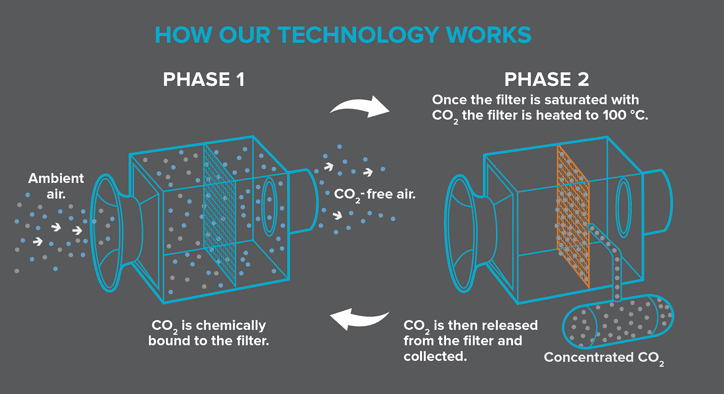| The future of CO2 reduction across the globe is an unknown at best.
Many observers, for example, have said that even if all the pledges for greenhouse gas reduction made at the 2016 UN Climate Accord were realized - a dubious proposition - that would not be nearly enough to keep temperatures from rising to dangerous levels.
In addition, no one really knows how emissions will change as developing economies make economic progress, and literally billions of people across the globe enter the middle class - and thus start using directly or indirectly a lot more energy, creating much higher levels of CO2 emissions.
Maybe the better answer - or at least part of the answer - is to simply remove CO2 from the atmosphere using technology.
That possibility has been discussed for years, but without a viable technology really there to support it. That appears to have changed.
A Swiss company called CIimeworks says it has technology that works and works affordably, using what the company calls its "CO2 Capture Plant," enabling "direct air capture" of the CO2.
The system works like this, as also shown in the graphic below:
A Climeworks plant captures atmospheric carbon using a filter. Air is drawn into the plant and the CO2 within the air is chemically bound to the filter.
Once the filter is saturated with CO2 it is heated (using mainly low-grade heat as an energy source) to around 100 degrees C. The CO2 is then released from the filter and collected as concentrated CO2 gas to supply to customers, or for "negative emissions technologies" - meaning some type of sequestering.
CO2-free air is then released back into the atmosphere. This continuous cycle is then ready to start again. The filter is reused many times and lasts for several thousand cycles.
How the Climeworks System Removes CO2 from the Air

The obvious question of course what to do with captured CO2. One option is to actually sell the CO2 to various industries, such as agriculture concerns. In fact, earlier this year the company contracted with a local farmer of tomatoes and cucumbers to supply 900 tons of CO2 per year to his greenhouses, where it works as a gaseous fertilizer, speeding up photosynthesis.
Climeworks notes that its system may be attractive to bottling companies, which can generate high purity CO2 on site, literally out of air. There are potential other industrial customers as well.
There may be other applications that emerge as well for using the gas, but at volumes that might potentially have a meaningful impact on atmospheric CO2 reduction, storing the captured CO2 must be the leading part of the mix, permanently sequestering the gas underground.
That of course raises all kinds of questions - starting with where the storage would occur, along with "Is it really permanent?" - but eventually getting to the big question: who pays for it all?
One possibility is that companies could pay for it say for machines to remove from the atmosphere an amount of CO2 equivalent to their own emissions. It could potentially be cheaper to do that than to reduce those emissions directly.
The first of the Climeworks systems went live in June. Each CO2 collector is a 7-foot-tall box fan with a tiny jet engine inside.
The founders, Christoph Gebald and Jan Wurzbacher, note the findings of the Intergovernmental Panel on Climate Change states that CO2 storage will be an essential part of meeting global targets for greenhouse gas reduction.
Each of the capture plants can collect about 50 tons of CO2 from the atmosphere a year. The founders declined to share pricing details Bloomberg's BusinessWeek, but said costs will fall rapidly once production ramps up. It will certainly take a lot of machines to make an impact.
By way of comparison, Walmart hopes to take a gigaton of future emissions out of its extended supply chain by 2030 through working with suppliers. With a gigaton equal to one billion tons, that would mean it would take 20 million Climeworks machines to have the same impact, at current levels of capture.
What do you think of the Climeworks machine? Would we just need to many to have any real impact? Let us know your thoughts at the Feedback button below.

|